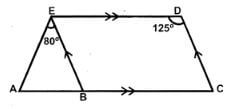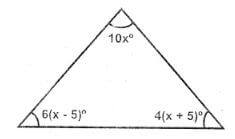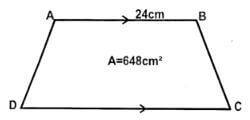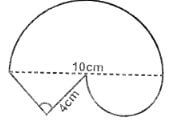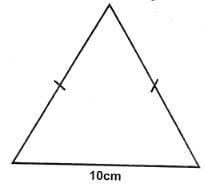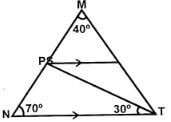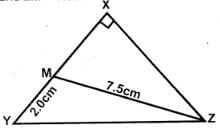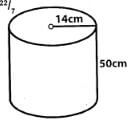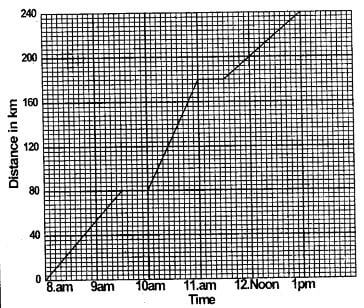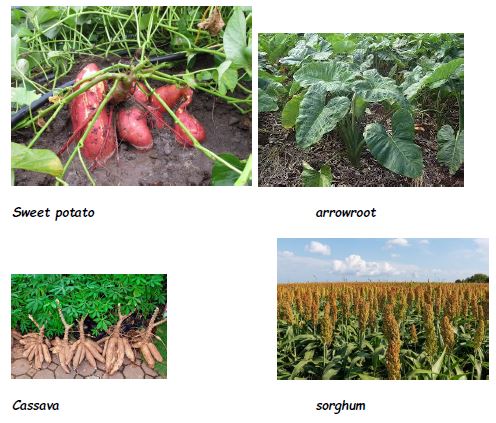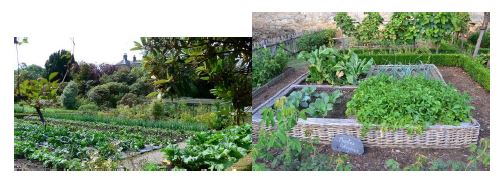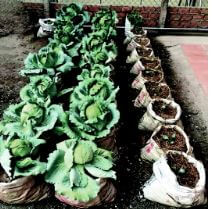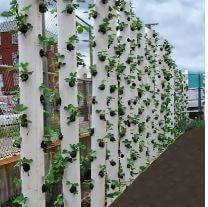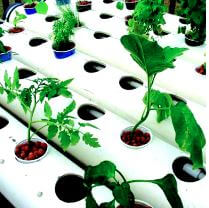Musya
Kiswahili Questions And Answers - Class 8 End of Term 2 2021 Set 2
KISWAHILI
DARASA LA 8
MWISHO WA MUHULA WA 2
Soma vifungu vifuatavyo. Vina nafasi 1 mpaka 15. Kwa kila nafasi umepewa majibu manne hapo. Jaza kila pengo kwa kuchagua jawabu lifaalo zaidi.
Nchi 1 Kenya hujivunia umoja na 2 wa hali ya juu. 3 kuna makabila mengi, lugha ya Kiswahili 4 na wakenya wa makabila mbalimbali ili 5 Vilevile wimbo wa taifa, michezo na bendera ya taifa husaidia 6 magugu ya ukabila na chuki. Kila binadamu, bila 7 kabila wala lugha yake, ana umuhimu mkubwa. Tunapoishi 8 amani na umoja, bila shaka uchumi wetu utaimarika Ni vyema kukumbuka kuwa 9
- A.la B.ya C.mwa D. kwa
- A. mgawanyiko B. utengano C. utangamano D. vurugu
- A. Ingawa B. Licha ya C. Lakini D. Hata hivyo
- A. hutangazwa B.husomwa C. huandikwa D. hutumiwa
- A. kuwastawisha na kuwalenga
B. kuwadunisha na kuwajenga
C. kuwaunganisha na kuwatambulisha
D. kuwahamasisha na kuwalinganisha - A. kupanda B. kupalilia C. kung'oa D. kunyunyizia
- A. kujua B. kujali C. kuthamini D. kutambua
- A. katikati B. kwa C. ndani ya D. kwenye
- A. umoja ni nguvu utengoni ni udhaifu
B. chururu si ndondondo
C. akiba halozi
D. haba na haba hujaza kibaba
Kijana 10 aliketi pale 11 baada ya hakimu kuamua kwamba afungwe kwa miaka kumi. Alifungwa kwa sababu ya utapeli 12 aliufanya akitumia simu. Pesa hizo za wizi zilimtajirisha hadi 13 katika jumba la kifahari. 14 siku yake ya arubaini ilikaribia, nayo ilipofika alikula 15 kwelikweli.
- A. yeyote B. ambaye C. mwenye D. mwenyewe
- A. gerezani B. rumande C. kizimbani D. chupani
- A. ambao B. ambayo C. ambalo D. ambaye
- A. akahama B. akaguria C. akahamishwa D. akagurisha
- A. Kumbe B. Pengine C. Kwa sababu D. Labda
- A. njama B. nyama ya ulimi C gumzo D. kalenda
Kuanzia nambari 16 mpaka 30. jibu kila swali kulingana na maagizo uliyopewa.
- Chagua orodha yenye vielezi vya idadi pekee.
- mmoja, wengi, wachache
- polepole, vizuri, haraka.
- mapema, asubuhi, jana,
- sana, tena, aghalabu.
- Maneno yafuatayo yatakuwaje katika kamusi kuanzia la kwanza hadi la mwisho?
- Bahati
- Babaika
- Bahari
- Baidika
- (iii), (i), (iv). (ii)
- (i), (iv) (iii) (i)
- (ii).(iii) .(i) (iv)
- (ii), (iii), (iv), (i)
- Ni orodha ipi yenye nomino za ngeli ya YA-YA pekee?
- maji, mate, mapishi.
- mazingira, mapishi, malezi.
- magonjwa, maumbo, maisha.
- manukato, mafuta, maradhi.
- Sentensi gani iliyo sahihi kati ya hizi?
- Mbuzi wowote watachinjwa kesho.
- Kitabu chenyewe kiliandikiwa ni chake.
- Nguo ile ingine itafuliwa
- Gari jeupe ni ya mwalimu.
- Chagua sentensi iliyotumia ki kuonyesha wakati endelezi.
- Ukienda nyumbani uniambie.
- Mbuzi alikuwa akilala fisi alipompata
- Watoto walimwona alipotembea kijeshi
- kijibwa chake kimepotea.
- 'Mawazo, hasira, furaha' ni mifano ya nomino za aina gani?
- Nomino za pekee
- Nomino za dhahania .
- Nomino za kawaida
- Nomino za wingi.
- Tambua sentensi ambayo inaonyesha istiara kati ya hizi.
- Wageni wote waliowasili ni malaika
- Mji ule ulimpokea kwa mikono miwi
- Wazazi wamekaa nyumbani wakisubiri watoto wao wachanga wawanunulie chakula
- Watu walijaa uwanjani hadi nafasi ya nzi kutua ikakosekana.
- Chagua ukanusho wa sentensi: Kitabu kilichopotea kimepatikana.
- Kitabu kilichopotea hakikupatikana.
- Kitabu kisichopotea hakijapatikana
- Kitabu kisichopotea hakikupatikana
- Kitabu kilichopotea hakijapatikana.
- Neno gani lililo na silabi nne kati ya haya?
- Potelea
- Lala
- Mbuzi
- Mbaya
- Chagua sentensi inayomaanisha kuwa Musa hakuchelewa kazini kwa kuwa aliamka mapema
- Musa asingechelewa kazini angeamka mapema
- Musa asingeamka mapema angechelewa kazini
- Musa angeamka mapema angechelewa kazini.
- Musa angechelewa kazini angeamka mapema
- Maelezo gani ambayo si sahihi kuhusu neno shinda?
- Kuwa na ugumu wa kutendeka.
- Ni kuwa wa kwanza katika mashindano.
- Ni kukaa mahali mchana wote.
- Ni dhiki au matatizo
- Sentensi ipi iliyotumia kiunganishi kwa usahihi?
- Maadamu alimshauri vizuri hakufaulu.
- Ilhali mtoto ameanguka hajalia.
- Umeshindwa kununua baiskeli sembuse gari!
- Minghairi ya kununua gari alisafiri haraka
- Chagua orodha yenye aina za mashain pekee.
- Utenzi, mizani, kibwagizo
- Ngojera, tarbia, utenzi.
- Ukwapi, utao, mwandamizi.
- Mwanzo, mloto, mleo.
- Tambua sentensi iliyotumia kivumishi cha idadi ya nafasi katika orodha
- Mwanafunzi wa pili anajua kuogelea.
- Madawati mengi yamepakwa rangi
- Mama amenunua marinda mawili.
- Mipira michache imenunuliwa.
- Wakati wa macheo, jua huwa upande gani wa dira?
- Mashariki
- Magharibi
- Kaskazini
- Kusini
Soma taarifa ifuatayo kisha ujibu maswali kutoka 31 hadi 40.
Ni nani mwenye akili razini awezaye kupata hata lepe la usingizi usiku kama huo? Niligaagaa kitandani huku nimetawaliwa na kiwewe na wasiwasi uliopiku ule wa mwasi. Niliwaza na kuwazua jinsi siku iliyofuata ingekuwa keshoye, ilikuwa siku ya kutangazwa kwa matokeo ya uchaguzi wa gatuzi letu Uchaguzi huo mdogo ulifanyika baada ya aliyekuwa gavana wetu kufumwa na mvi wa manaya katika ajali ya barabarani. Bila shaka, hakuna aliyetarajia kwamba ningekuwa nambari ya pili, sembuse nambari ya kwanza? Ilikuwa wazi kama pengo kuwa ningeburura mgwisho. Tangu lini mja asiyekuwa na misuli ya kihela akaibuka mshindi katika kinyang'anyiro chochote cha uchaguzi? Licha ya kuwa mkata aliyekatwakatwa na ukata, nilitoka katika kabila lenye watu wachache mno.
Asubuhi ilipofika, nilichukua baiskeli yangu na kuiendesha polepole huku wafuasi wangu wakinishangilia nilipopita. Tuliwasili katika ukumbi wa kaunti ya Ingusi, ambapo matokeo ya uchaguzi huo yangetangaziwa. Ukumbi huo ulijaa sisisi ya watu wake kwa waume, wazee kwa vijana, waliosoma kwa wasiosoma. Mashangingi ya wapinzani wangu yalikuwa yameegeshwa pale nje. Maafisa wa polisi walizunguka hapa na pale ili kuhakikisha kuwa hakuna uhalifu uliotokea.
Afisa wa tume ya uchaguzi alipokichukua kinasasauti, kila mtu alitulia tuli kama maji mtungini. Kimya cha makaburini kilitanda kote, hata unywele ungedondoka chini ungesikika kama mlipuko wa bomu katika ukimya huo, afisa huyo alikoroma na kupasua ukimya uliokuwa umetawala. "Mshindi wa uchaguzi huu ni Amani Mlachake". Wote walionipinga waliduwaa kama mja aliyedungwa sindano ya ganzi. Wengine wote waliokuwa wakigombea kiti hicho walidhani kuwa walikuwa katika ndoto mbaya. Rafiki yangu Nyangweso na kundi lake la watumbuizaji walianza kupiga isukuti. Akina mama walisakata densi ya mabega yao. Vijana wenzangu waliniinua juu kwa furaha. Sherehe na shangwe hizo zilifanyika bila kujali mipaka ya ukabila.
Hewaa! Jua la mabadiliko lilikuwa limechomoza. Hiyo ilikuwa siku mpya. Tofauti na hapo awali, uchaguzi wa kiongozi ulikuwa umefanyika bila kuzingatia kuwa mkono mtupu haulambwi. Wale waliodhani kuwa wangechaguliwa madhali walikuwa wakiwarambisha wapigakura asali walinamisha vichwa vyao kwa tahayuri Walikuwa wamekula inwande. Aidha, waliokuwa wakijipiga kifua kuwa kiongozi alichaguliwa kwa kuegemea dhana ya ukubwa wa kabila lake waliinamisha vichwa na kujiendea zao.
Niliutuliza umati uliokuwa umepandwa na jazba. Hamrerehamrere na chereko zilipotulia, nilichukua kinasasauti ili niwashukuru raia walioniunga mkono. "Ninawapa shukrani za dhati kutoka sakafuni pa mtima wangu. Ninawakumbusha kwamba ahadi zote nilizowapa hazikuwa ahadi za Kiswahili. Vilevile, ninawapa shukrani kwa uzalendo wenu. Shughuli za uchaguzi zilifanyika bila fujo wala vurugu. Hata baada ya mshindi kutangazwa, sijaona visa vya uharibifu wa mali kama hapo awali. Nyinyi ni mashujaa na wazalendo kindakindaki."
- Kwa mujibu wa aya ya kwanza:
- msemaji alishindwa kulala kwa kuwa hakujua kama matokeo ya uchaguzi yangetangazwa
- msemaji hakutarajiwa kuwa nambari ya pili bali ya kwanza
- watu walitarajia kuwa msemaji angekuwa wa mwisho katika uchaguzi
- msemaji alikuwa tajiri aliyetoka katika kabila la watu wachache mno.
- Juhudi za msemaji kuwa kiongozi zilikumbwa na changamoto gani hasa?
- Umaskini na ukabila
- Ufisadi na utepetevu
- Utapeli na unyanyapaa
- Ukata na utapeli
- Nahau zifuatazo zina maana sawa na 'kufumwa na mvi wa manaya' ila
- kukata kamba
- kuaga dunia
- kuacha mkono
- kuenda nguu
- Maneno, hata unywele ungedondoka chini ungesikika kama mlipuko wa bomu ni mfano wa Tani yani ya lugha?
- tashbihi
- istiara
- chuku
- tanakali
- Matokeo ya uchaguzi yalipotangazwa
- kila mtu alifurahia matokeo
- kila mtu alienda nyumbani
- watu wengi walifurahi lakini wengine hawakuamini
- watu wote walimwinua msemaji kwa furaha.
- Maneno, hiyo ilikuwa siku mpya' yana maana kwamba ilikuwa siku ya
- uchaguzi
- mabadiliko
- sherehe
- matokeo
- Kulingana na aya ya nne, ni kweli kuwa
- jua lilipochomoza lilileta mabadiliko
- uchaguzi huo ulikuwa tofauti na wa siku za awali
- watu walishindwa kuulamba mkono mtupu
- ushindi wa msemaji ulifanya watu wajipige kifua
- Ufahamu huu unatufundisha kwamba:
- tusiogope kujaribu jambo hata kama hali ni ngumu
- tuheshimu watu wa makabila yetu kushinda wa makabila mengine
- tuchague viongozi ambao wana pesa pekee
- watu ambao hawana pesa hawawezi wakafaulu katika jambo lolote.
- Kwa nini msemaji anawashukuru wapigakura katika aya ya mwisho?
- Walimpigia kura vizuri.
- Waliungana kusherehekea ushindi wake
- Walipiga kura kwa amani bila fujo wala vurugu
- Walifanya kazi kwa bidii na umoja
- Kulingana na mwandishi, alipanga kuzingatia methali gani katika aya ya mwisho?
- Jitihada haiondoi kudura.
- Dau la mnyonge haliendi joshi.
- Mkono mtupu haulambwi.
- Ahadi ni deni na dawa ya deni ni kulipa
Soma taarifa ifuatayo kisha ujibu maswali 41 mpaka 50.
Ukeketaji ni dhuluma ambayo huendelezwa na baadhi ya jamii humu nchini. Licha ya serikali kujifunga kibwebwe ili kukabiliana na jinamizi hili, bado linatishia kuendelea kuharibu mustakabali wa vijulanga wa kike humu nchini. Kuna viongozi wa kidini hapa nchini ambao huegemea mila na desturi za jadi katika jamii na ambao kisiri huunga mkono ukeketaji, hivyo basi kuhujumu vita dhidi ya ukeketaji. Pia hali ni tofauti kabisa ambapo shughuli hiyo ambayo zamani iliendeshwa kisiri vichakani hasa huko mashinani, leo hii imekuwa ni biashara ya faida na ambapo kuna wauguz ambao hulipwa ili kukeketa katika usiri wa vyumba vya kifahari na pia katika hospitali
Aidha, kuna wakuu wa kiusalama ambao wamethibitisha kuwa wauguzi wengine wamejiunga na wale ambao wamekataa katakata kutupilia mbali tohara ya wanawake katika jamii. Wengi wac wanachochewa na tamaa ya kujipa pato. Hii ni ithibati ya kutosha kuwa umaskini ni mojawapo ya vizingiti vikubwa katika vita dhidi ya ukeketaji. Hata hivyo, si umaskini tu bali pia unyama. Unyama huu unatokana na ukweli kwamba ukeketaji huu una madhara si haba kwa yule anayekeketwa. Kwa hivyo, mtu anayethamini hela anazopewa kushinda maslahi ya mwenzake ni mwovu anayefaa kutiwa mbaroni na kuozea katika jel
Uchunguzi wa hivi karibuni umedhihirisha kuwa idadi kubwa ya wale waliokumbatia ukeketaji huu ama hawajui madhara yake au wanajitia tu hamnazo. Kuna wale ambao kwa kupofushwa na kauli kuwa mwacha mila ni mtumwa, wanajitolea mhanga kiasi cha kuwakeketa hata wasichana ambao wangali tumboni. Ni faradhi kila mkenya afahamu kuwa njia za kitamaduni za ukeketaji zina madhara si haba. Uvujaji wa damu kiasi cha kusababisha kifo ni mojawapo tu ya athari hizo Isitoshe, ngariba alikuwa na mazoea ya kutumia kijembe kimoja kuwapasha wasichana kadhaa tohara. Hali hii ilitokea kuwa rutuba ya kukuza maangamizi.
Ukeketaji wowote ule, uwe wa kale au wa kisasa, humwathiri mhusika kisaikolojia. Dhuluma hii huweza kumfanya mhusika huyo asijichukie tu bali pia jamii nzima iliyochangia kumletea madhila. Baadhi ya wale waliopitia ukatili kama huu, wasiposaidiwa kupona majeraha ya moyoni, huweza kulipiza kisasi kwa wenzao au hata kuishi maisha yaliyosheheni uchungu na maumivu ya ndani kwa ndani.
Ni jukumu la kila mkenya kutathmini faida tunazopata kutokana na mila na desturi zetu. Mila na desturi zisizokuwa na umuhimu wowote zitupiliwe mbali. Ukeketaji una faida gani? Wale waliokeketwa wanawashindia nini wale ambao hawajakeketwa? Tukilipiga suala hili darubini tutang'amua kuwa ukeketaji hauleti faida yoyote. Ni msisitizo utokao kwa wanajamii wanaodai kuwa mwacha mila ni mtumwa. Je, hawajui kuwa mwacha mila potovu ni mtume?
- Aya ya kwanza inadokeza kuwa ukeketaji
- huendelezwa na jamii zote humu nchini
- unatishia kuimeza serikali humu nchini
- unaendelea ingawa serikali imekuwa ikijaribu kukabiliana nao
- unaunga mkono kisiri viongozi wa kidini.
- Makala yanaeleza kuwa ukeketaji siku hizi;
- hauna tofauti kubwa na wa hapo awali.
- hauendeshwi kabisa huko mashinani na vijijini
- ni biashara ambayo inaleta faida kote nchini
- hufanywa kisiri hospitalini na katika majumba ya kifahari.
- Ni nini hasa kinachowafanya wauguzi wajiunge na shughuli ya ukeketaji?
- Uzalendo
- Umaskini
- Utamaduni
- Ukale
- Kwa mujibu wa aya ya pili, imebainika kwamba;
- tunafaa kuwathamini wenzetu kushinda hela tunazoahidiwa
- umaskini ndiyo sababu pekee inayoendeleza ukeketaji
- idadi ya wauguzi ambao wanaendeleza ukeketaji inazidi kupungua.
- waliopatikana wakiendeleza ukeketaji walitiwa mbaroni na kuozea jela.
- Maneno, 'wanajitia tu hamnazo' yana maana gani jinsi yalivyotumika katika kifungu?
- Wanajipeleka jela
- Wanajifanya kuwa hawajui.
- Wanajiletea shida
- Wanashirikiana na wakeketaji.
- Aya ya tatu inadokeza kuwa madhara ya ukeketaji ni;
- kifo na athari za kisaikolojia
- ugonjwa wa UKIMWI na athari za kisaikolojia
- kifo na kusambaza ugonjwa wa UKIMWI
- uvujaji wa damu na madhara ya kisaikolojia
- maumivu ya ndani kwa ndani' ni yale ambayo:
- hayana athari zozote
- yanaonekana na kila mmoja
- hayawezi yakatulizwa
- yanamtesa mtu ingawa hayaonekani
- Makala haya yanaeleza kuwa ukeketaji wa kale au wa kisasa;
- haumwathiri mhusika kisaikolojia
- hufanya mhusika asijichukie
- hufanya mhusika ajichukie na pia kuichukia jamii iliyohusika
- hulipiza kisasi kwa wenzao.
- Ili kukabiliana na ukeketaji, tunafaa
- kufunza athari za UKIMWI na kuwatia mbaroni
- kuimarisha uchumi na kufunza jamii madhara yake.
- kuonyesha jamii madhara na kuondoa umaskini
- kufunza jamii madhara ya umaskini na kuimarisha ukeketaji.
- Aya ya mwisho inabaini wazi kuwa,
- mila zinaweza zikawa na faida na nyingine zina madhara
- mila zina madhara pekee
- mila hazina faida yoyote
- tufuate mila zote za kiafrika
MARKING SCHEME
- B
- C
- A
- D
- C
- C
- B
- B
- A
- D
- A
- A
- B
- A
- D
- D
- C
- D
- A
- B
- B
- A
- D
- A
- B
- D
- C
- B
- A
- A
- A
- A
- D
- C
- C
- B
- B
- A
- C
- D
- C
- D
- B
- A
- B
- C
- D
- C
- B
- A
English Questions And Answers - Class 8 End of Term 2 2021 Set 2
ENGLISH
STD 8
END TERM 2
Fill in the blank spaces numbered 1 to 15 with the best alternative from the choices given
Doubtlessly, 1 of us 2 ourselves patriots. And we have 3 to prove it; we cheer our Harambee Stars 4 when they are playing international 5 What's more, when our 6 are competing in foreign capitals, we 7 them 8 all the enthusiasm we 9 muster. Actually, some of us 10 been observed to heave and pant 11 rhythm with our fellow Kenyan competitors as we 12 them on television Wonderful and 13 t hough it is to identify with, and celebrate the 14 of our countrymen and women, we need to do 15 more to earn the label 'patriot'.
- A few B. much C. many D. none
- A. consider B. considers C. think D. thinks
- A details B. information C. news D. evidence
- A. horse B. hoarse C. even D. deaf
- A world cup B. matches C. champions D. leagues
- A. athletees B. athletics C. athletes D. runners
- A. route for B.root for C. route at D. root at
- A with B. in C. and D. by
- A. could B. would C. should D. can
- A. were B. had C. have D. has
- A. by B. off C. on D.in
- A. look B. watch C. observe D. stare
- A. noble B. nobble C. vain D. absurd
- A exports B exploits C. exploit D. exploitation
- A. many B. alot C. a lot D. most
For questions 16 to 18. choose the correct form of the verb to fill in the blanks.
- The terrorist was arrested and the following day
- hang
- hunged
- hung
- hanged
- I was advised to stop in the hot sun due to my healthy.
- laying
- lie
- lying
- lieing
- Several good songs were yesterday
- sung
- sang
- singing
- to sing
For questions 19 to 21. choose the most suitable preposition to fill the blanks.
- I was congratulated being the top student last year.
- on
- for
- by
- with
- All the players practised prior the final match
- for
- to
- with
- of
- The headmaster asked me to write to him confidence
- with
- for
- on
- in
For questions 22 and 23. choose the word closest in meaning to the one underlined.
- We hardly go on trips in this school.
- always
- never
- frequentl
- rarely
- My friend proved to be very cunning
- shy
- stupid
- foolish
- bright
For questions 24 and 25. choose the correctly spelt words.
-
- Fullscap
- Recieve
- Definite
- Embarassment
-
- Occured
- Occasion
- Fourty
- Until
Read the passage below and then and the questions 26 to 38.
Jacob started smoking and taking alcohol when he was in Form Three, after having been influenced by his peers. He was introduced to drugs by a "friend who lived in the same dormitory with him. At first he was reluctant, but later he started to feel it wasn't a bad idea af been a very bright student, but now his performance had deteriorated markedly. And because of this new lifestyle, he narrowly made it to one of our public universities.
By the time he joined the university, Jacob had become clinically a drug addict. The addiction was so severe that he would even steal money from his colleagues to buy drugs. In the meantime, he was barely making it in his studies. He would skip lectures and tutorials; and he even missed an examination. The university doctors reported that he was suffering from drug dependency, and he was subsequently discontinued.
After being sent away from the university, Jacob became a destitute. For a while he kept away from his family: he didn't know how to explain to them what had happened. And being cut off from family and relatives meant he didn't have anybody to help, nay, to feed him, on a regular basis. He, therefore, went on the streets and became a beggar. But being a beggar in the streets of Nairobi is a step away from being a pickpocket and a shoplifter, and that is exactly what he became.
The inevitable happened. The law caught up with him, and the poor fellow was locked up for two years.
Jacob was released from jail last year, and as I write this essay, he is trying to recover from his drug addiction. He sees a counsellor regularly, and tries to interact with his family, relatives and friends. At one time, his parents had given up on their son, but after counselling, they have taken the view that Jacob was sick and is now recovering. The fact that the sickness was selfinduced is neither here nor there.
During the period of his addiction, this young man was always withdrawn and uncommunicative. It was as if he lived in a world of his own. Occasionally, he would be violent and abusive. But now he is warmer and more personable. He talks more openly with members of his family, and he also tries to reach out to his friends.
In order to fully recover, Jacob must do three things.
First, he must completely come out of the stage of being in denial. He needs to face the unpleasant fact that he was addicted to drugs and drug addiction which is an emotional as well as a medical condition. Being in denial is tantamount to refusing to accept the reality. It is refusing to accept the truth, to swallow the bitter pill; and as they say, truth shall set us free.
- According to the first paragraph, it is true to say that Jacob.
- took to drugs in Form Three.
- was not yet a teenager when he started smoking and taking alcohol.
- had a friend who was already an addict
- knew from the beginning that drugs were good.
- His performance in school
- remained above average
- was not affected in any way
- went down drastically
- allowed him very good grades.
- In the final exam, Jacob
- narrowly made it
- narrowly misused the marks
- was exemplary
- failed.
- To sustain his drug addiction, Jacob
- was clinically a drug addict
- stole money from friends
- stole valuables from kith and Kin
- barely made it in his studies.
- Why was Jacob discontinued with his university education?
- He become a thief.
- He failed in his exams.
- He was diagnosed with drug dependency
- He skipped lectures
- The phrase "Jacob became a destitute' means that he
- was now an orphan
- was now an illegitimate child
- was now a destroyed character
- had no means to provide for himself.
- On the streets, Jacob did all the following except
- banditry
- pick pocketing
- shoplifting
- begging
- The phrase "the inevitable happened means tha
- the unavoidable came to pass
- the unknown caught up with him
- the worst came to pass
- the unexpected came to pass
- After his two year-jail term, Jacob
- continued with his drugs use
- was rejected by all
- got support from his family
- started a rehabilitation centre.
- All the following describe Jacob during his addiction except
- affable
- withdrawn
- rude
- violent.
- The word "personable' as used in the passage is a
- noun
- adjective
- adverb
- verb.
- Being in denial means that Jacob
- knows he is addicted to drugs
- thinks he is not addicted to drugs
- has denied his family members
- is not sick at all.
- Jacob's predicament can be summed up as
- a fool and his money are soon parted
- all work and no play makes Jack a dull boy
- every dog has its day
- a small leak will sink a great ship.
Read the passage below and answer questions 39 to 50.
Some people imagine that life would be much more interesting if they were allowed to do exactly what they wanted. But in my view, such thinking is mistaken because behaviour that is not controlled would lead to anarchy. Just imagine what would happen if every motorist drove on the right or the left or in the middle of the road, and ignored traffic lights or speed limits. In a city like Nairobi, one would probably be stuck in a jam for a month, covering a distance of a hundred metres on a good day. When everybody observes the rules, things run smoothly.
Obedience is not a sign of weakness or cowardice. Rather, it is the recognition of the fact that respecting lawful authority leads to social order and harmony. Obedience means doing what is expected. It is also the acknowledgement that the common good transcends individual interests. Of course we must carefully think about what others tell us to do. We must not blindly. follow every instruction. For example, if someone tells you to commit a crime, you have an obligation to defy such an order however senior the person is. What we should obey are rules or instructions that are reasonable; in other words, those that are meant to promote the common good.
Now, why do some people find it difficult to obey parents, teachers or other authorities? The main reason is that they are self-centred. Their primary motivation is to pursue only those things. that benefit them, those that advance their private interests. And because obedience involves doing what others tell them, and frequently having to sacrifice their own desires, their spirits rebel. However, if they would consider the benefits of obedience, they would want to nurture this virtue.
In our everyday existence, we unconsciously obey many rules. No one, for instance, forces us to eat a balanced diet or obey a doctor's instruction. Many of us also report to school or places of work when we are supposed to. If you own a car, no one forces you to take it for service. Why do we do these things almost automatically? Obviously, it is because any act of disobedience would have grave consequences. So, obedience leads to a harmonious, stress-free life
Young people often find it difficult to accept rules and regulations because they think they are unfair or old-fashioned. It is true that some requirements may be illogical, but it pays to consider the motive behind the requirement before dismissing it offhand. Moreover, people we regard as old-fashioned may have a lot of experience and insight. Many have defied their parents' instructions and suffered much heartache later. It should be encouraging to know that even when some parents and teachers appear harsh and uncompromising, they have the best of intentions
- According to the author, uncontrolled behaviour would lead to
- interesting life
- lawlessness
- ignorance
- freedom.
- If there was anarchy on the roads in Nairob
- traffic snarl ups would be endless
- traffic would flow smoothly
- people would only travel for a hundred kilometres
- many cars would break down.
- Which one of the following would not lead to clogged traffic in Nairobi?
- Driving on the wrong side.
- Disregarding speed limits.
- Covering a distance of a hundred metres,
- Ignoring traffic lights
- All the following define obedience except
- respecting lawful authority
- doing as expected of you
- as a sign of weakness or cowardice
- the common good overrides self interest 43. 'We must not blindly follow every instruction' means that
- all that glitters is not gold
- one should look before leaping
- birds of a feather flock together
- every dog has its day.
- The writer, in paragraph two, advises us to
- obey all rules and instructions
- obey all rules but not all instructions
- disregard all fair rules
- obey rules and instructions that promote the common good.
- Why do some people disobey?
- They are egocentric.
- They are tactful.
- They are kind
- They are sensitive
- Obedience is a virtue.
- What is the opposite of virtue?
- Vice
- Fortitude
- Prudence
- Rectitude
- The phrase 'grave consequences' as used in the passage would mean
- deadly results
- serious results
- ultimate results
- obvious results
- Obedience leads to
- stressed free life
- a harmonious life with stress
- stress-free life and harmony
- automatic stress free life
- According to the last paragraph, it is true to say that
- when all leaders appear harsh, they have the best of intention
- some parents may appear uncompromising but they have very good intentions
- young people disobey rules because they are old fashioned
- many of the requirements are illogical
- Which one of the following would be the best title for the passage?
- Obedience as a sign of weakness
- The old fashioned.
- Anarchy in the streets.
- The sweet fruits of obedience.
MARKING SCHEME
- C
- A
- D
- B
- B
- C
- B
- A
- D
- C
- D
- B
- A
- B
- C
- D
- C
- A
- A
- B
- D
- D
- A
- C
- B
- A
- C
- A
- B
- C
- D
- A
- A
- C
- A
- B
- B
- C
- B
- A
- C
- C
- B
- D
- A
- A
- B
- C
- B
- D
Mathematics Questions And Answers - Class 8 End of Term 2 2021 Set 2
MATHEMATICS
STD 8
END OF TERM 2
- Which one of the following is eleven million four hundred thousand six hundred and eleven in symbols?
- 11400161
- 11040611
- 11400611
- 11004611
- What is the place value of digit 5 in the number 645732?
- 5000
- Hundreds
- Ten thousands
- Thousands
- What is the Highest Common Factor of 48, 72 and 54?
- 6
- 12
- 32
- 864
- What is 5798923 rounded off to the nearest thousands?
- 5790000
- 5799000
- 5798000
- 579800
- What is the next number in the sequence below?
1½, 2 1/6, 2 5/6, 3½, ____- 4 1/6
- 4 1/3
- 4 1/2
- 5 1/6
- What is the square root of 5 4/9?
- 1 7/9
- .2 1/3
- 2 2/3
- 7/9
- Which one of the following computations gives a fraction equivalent to 7/9?
- 5 x 2
6x3 - 7x3
3 x 9. - 9-2
11 + 2 - 7X2
18 + 2
- 5 x 2
- In the figure below, BCDE is a quadrilateral. Line ABC is a straight line. Line AC is parallel to ED and line EB is parallel to DC. Angle AEB = 80° and EDC = 125°.
Find the value of angle EAB.- 55°
- 135°
- 45°
- 80°
- What is the least number that should be added to 3661 to make it divisible by 8?
- 5
- 2
- 3
- What is the value of:
4.5+ 3.6 x 1.2 + 1.36
0.5- 20.36
- 19.32
- 19.00
- 10.18
- The price of a suit was increase by Shs.400. If this was 20%, what was the price of the suit before the increase?
- Shs. 2400
- Shs. 2000
- Shs. 1800
- Shs. 1600 12.
- 1.5 tonnes of sugar were packed in 750g packets. How many packets were obtained?
- 2
- 200
- 2000
- 20
- What is the perimeter of the figure below given that OB is the diameter of the semi circle? (π=22/7)
- 120cm
- 140cm
- 126cm
- 112cm
- The difference of two numbers is 850. The smallest number is 717. What is the other number?
- 1467
- 1667
- 1567
- 133
- Kamau is three times as old as his sister Ten years ago, their total age was 24 years How old will Kamau be in 3 years times?
- 36 years
- 11 years
- 14 years
- 33 years
- What is the value of:
ab2(c2 - 2a)
c
where a = b + 3, b = c - 2 and c = 4.- 55
- 30
- 15
- 70
- The figure below shows a triangle
What kind of a triangle is it?- Right angled triangle.
- Equilateral triangle
- Scalene triangle
- Isosceles triangle
- Alice bought 15 cartons of milk. A carton contains thirty six-500ml packets of milk. How many litres of milk did Alice buy altogether?
- 27000L
- 54000L
- 270L
- 450L
- What is the value of w in the equation.
W+1 + 3 = 6?
2- 2
- 5
- 4
- 8
- Construct triangle ABC in which AB = 6.5cm, AC = 5cm and angle ACB = 60°. What is the length of line CB?
- 5.2cm
- 4.9cm
- 5.9cm
- 6.9cm
- The area of the trapezium below is 648cm2.Line AB is 24cm and the perpendicular height is 18cm.
Find the length of line DC- 72cm
- 96cm
- 24cm
- 48cm
- Adagi bought a watch for Shs. 342 after he was allowed a discount. If the marked price was Shs. 360, what was the percentage discount?
- 5%
- 18%
- 22%
- 6 1/9%
- The temperature of ice was 14° below the melting point. It was heated to a temperature of 68°C. What was the rise in temperature?
- 54°C
- 72°C
- 68°C
- 82°C
- The length of a rectangle is 36cm. Itsdiagonal is 45cm. Calculate its perimeter?
- 126cm
- 162cm
- 81cm
- 61cm
- Three traffic signals are set to flash at intervals of 24 min, 30 min and 36 min. It they flashed together at 9:10a.m, at what time had they flashed together before?
- 3:10pm
- 9:16am
- 10:40pm
- 3:10am
- What is the area of the shaded part in the figure below?
- 20cm2
- 72cm2
- 30cm2
- 36cm2
- Kemunto bought the following items from a shop:
2kg of rice at Shs. 75.
3 packets of flour at Shs. 120.
2 1/2 kg of sugar at Shs. 50.
2 packets of coffee for Shs. 150.
She paid for the items with two-sh.500 notes. What balance did she get?- Shs. 785
- Shs. 65
- Shs. 215
- Shs. 225
- The ratio of men to women in a meeting was 4:5. There are 70 more women than men in the meeting. How many women were there?
- 350
- 630
- 280
- 400
- What is the perimeter of the figure below. The diameter of the semi-circle is 10cm (Take = 3.14)
- 32.55cm
- 30.55cm
- 23.44cm
- 29.55cm
- A book seller sold Distinction Mathematics text book for Shs. 720 making a 10% loss. How much would he have sold the book to make 20% profit?
- Shs. 880
- Shs. 800
- Shs. 960
- Shs. 864
- A circular pond has an area of 2464m2. It was fenced round using five strands of wire. What is the length of the wire used? 1=22%,
- 789m
- 280m
- 176m
- 880m
- A motorist travelled at a speed of 60km/h for 2hrs. He then increased the speed by 10km/h for other 2 hours. What was the average speed for the whole journey?
- 65km/h
- 64km/h
- 70km/h
- 68km/h
- What is the sum of the mean and the mode of the following numbers?
4, 5, 6, 7, 5, 9, 5, 8,5- 6
- .5
- 10
- 11
- Simplify:
1/2(2x - 14 - 6) + 1/4(8x + 36y + 12)- 3x + 2y - 6
- 3x + 2y + 6
- 3x + 2y
- 3x + 16y +6
- 8 workers were expected to take 24 days to complete some work. Two failed to turn up. How many more days did the work take the remaining workers to complete the work?
- 32
- 8
- 18
- 6
- The perimeter of the triangle below is 36cm.
What is the area of the triangle above?- 60cm
- 120cm
- 30cm
- 65cm
- Luka borrowed Shs. 25500 from a bank that charged simple interest at a rate of 15 % p.a. If he paid all the money after 8 months, how much did he pay?
- Shs. 25050
- Shs. 2550
- Shs. 2813
- Shs. 2635
- A length of 5cm was drawn on a map to represent a river of 80km long. What is the scale of the map?
- 1:16000000
- 1:1600000
- 1:160000
- 1:16000
- After paying a commission of 7% of the price of a vehicle to an agent, the owner of the vehicle was left with Shs. 232500. How much was paid to the agent?
- Shs. 17500
- Shs. 17275
- Shs. 16275
- Shs. 25000
- In the figure below, line MN = MT, angle NMT = 40°, angel PTN = 30° and angle PNT = 70°
What is the measure of angle MPT?- 30°
- 100°
- 80°
- 70°
- The area of a square piece of land is 0.64ha. What is its perimeter in metres?
- 80m
- 320m
- 6400m
- 8000m
- Naliaka bought 1000 bananas at Shs. 5 each. On the way, 43 bananas got spoilt. She sold the rest in piles of 11 bananas at Shs. 88 each pile. What was the profit made?
- Shs. 6656
- Shs. 1656
- Shs. 5000
- Shs. 2656
- Timothy bought a T.V set through a hire purchase terms by paying a deposit of Shs. 9500 followed by 20 monthly installments of Shs. 920 each. If the cash price was Shs. 24000, how much more than the cash price did he pay for the TV set?
- Shs. 3900
- Shs. 13580
- Shs. 15100
- Shs. 5600
- The figure below shows a right-angled triangle YXZ. Line XY = 6.5cm, MY = 2.0cm and ZM = 7.5cm. 7.5cm
What is the area of triangle MZY?- 6.5cm
- 13.5cm
- 6.0cm
- 18.5cm
- What is twice the value of:
1/2 of 3/4 + 1/8 (7/9 - 2/3) ÷ 1/4?- 31/36
- 31/72
- 1/4
- 17/18
- What is the surface area of the solid drawn below?(π=22/7)
- 50016cm
- 30800cm
- 2992cm
- 5632cm
- What is the total value of digit 3 in the number? 6835290
- 3000
- Ten thousands
- Thirty thousand
- 300000
- The table below shows distance in km between different towns. Thika 80 Kenol 113 1140 Sagana 160 120 40 Karatina What is the distance from Sagana to Thika via Kenol?
- 40km
- 160km
- 113km
- 220km
- Mr. Stephen paid Shs. 1800 for an item after he was allowed a discount of 10%. How much was the marked price?
- Shs. 2000
- Shs. 1980
- Shs. 1620
- Shs. 2180
- The graph below shows the journey of a motorist.
What was his average speed for the whole journey?- 60km/h
- 48km/h
- 72km/h
- 100km/h
MARKING SCHEME
- C
- D
- A
- B
- A
- B
- B
- C
- D
- C
- B
- C
- D
- C
- A
- B
- C
- C
- B
- C
- D
- A
- D
- A
- A
- B
- C
- A
- B
- C
- D
- A
- D
- C
- A
- A
- C
- B
- A
- B
- B
- D
- A
- C
- B
- D
- B
- C
- A
- B
Christian Living - CBC Grade 5 CRE Revision Notes
- Friendship Formation
- Human Sexuality
- God: The Source Of Life
- Good Health Practices
Friendship Formation
- This is the process of making and maintaining friends.
- Friendship is an integral part of human life because human beings are social beings.
- There is a need for people to be very careful on how they choose their friends.
Peer Influence
- Peer influence is the effect your friends or age mates have on your behavior.
- We should be keen when choosing friends since they influence our behavior. Bad friends and groups can ruin our lives.
- Peer influence is the strong pressure to an individual to adopt the attitude, values, behavior and thoughts of his or her peer group.
Qualities Of A Good Friend
- Read 1 Thessalonians 5:11 and Galatians 6:2.
- Friends should help one another.
- A good friend should encourage his or her friends.
- Friends should help carry one another’s burdens.
- He should be caring.
- He should be loving.
- A good friend should be truthful.
- He or she should be kind.
- He or she should be compassionate.
- Should be one who is humble.
- A good friend should be respectful and responsible.
Values Useful In Maintaining Good Friends
- The useful values in maintaining good friends are;
- Honesty, trust, caring, obedience, respectful, selflessness, kindness, truthful, loving, peace, thankfulness, humility.
Causes Of Poor Choice Of Friends At Home And School
- Low self-esteem.
- The desire to prove oneself to others. Lack of proper role models to emulate. Failure to obey the school rules.
- Failure to obey God’s commandments.
Good Friendship
- Teaches us how and when to forgive.
- Help us deal with stress.
- Help us during our difficult times.
Human Sexuality
- Adolescence is a developmental stage in life. The developments are both physical and emotional.
- Adolescence is the period during which children grow from childhood to adulthood.
Changes Associated With Adolescence In Boys And Girls
Physical Changes In Boys
- Shoulders widen.
- Chest broaden.
- The voice breaks.
- Growth of pubic hair.
- Oily face.
- They sweat a lot.
Physical Changes In Girls
- Body increases in size and shape.
- Breasts grow.
- Waist and hips become more obvious.
- Menstrual flow starts.
- Growth of pubic hair.
- Face tends to be oily.
- They sweat a lot.
- Emotional Changes during adolescence are changes of the feelings other people or situations. These changes include mood swings, stress, irritations or getting easily upset.
How To Cope With Body Changes During Adolescence
- In case one experiences these changes, he or she should report to the parent or guardian, teacher or a trusted adult for moral support and advice.
- Adolescents need to accept these changes, as it is part of growth. It is how God created every human being.
- It is important to get the right information about adolescence in order to understand and handle the stage the right way.
Healthy And Unhealthy Boy Girl Relationship
- Read 1 Corinthians 6:18-19.
- A healthy boy girl relationship is one that has mutual respect, trust, honesty, understanding, role models, and good communication. Activities that show a healthy boy girl relationship include playing together, studying together, cleaning together, respecting each other.
- An unhealthy boy girl relationship has bad behaviours and mentality, lacks self control, negative influence, dishonesty and disrespect.
- Our body is the temple of the Holy Spirit and we should take care of it since it was given to us by God to use to glorify Him.
- We should not commit sexual sin.
Effects Of Unhealthy Boy-girl Relationship
- It can lead to early pregnancies.
- It can also lead to school dropouts.
- Unhealthy boy girl relationship can make us feel bad and unhappy about ourselves.
- It can also hurt our bodies.
- It lowers our dignity and self-esteem.
Overcoming Unhealthy Boy-girl Relationship
- In order to achieve this, we should;
- Get good friends who respect you.
- Keep yourself busy in constructive activities.
- Read the bible.
- Focus on the qualities you would want to have in a friend.
- Be assertive.
- Meet with the opposite sex in open place
- Ask your guardian or trusted adults for advice.
God: The Source Of Life
- Human life is given by God.
- No one has the right to take it away. Life is holy and sacred.
- It is God alone who has the right of taking life away.
Christian Teachings On God As The Only Source Of Life
- Read Genesis 1:27, Genesis 9:6, Psalms 49:7-8.
- Life is a gift from God.
- God created human beings according to Genesis 1:27.
- Psalms 49:7-8 teaches us that payment for human life is too great and can never be paid enough.
- We should protect life.
- Human life is made in the likeness of God.
- We should say NO to substance abuse and sex.
- We should inform our parents if we are sick.
- We should avoid playing dangerous games.
Causes Of Violation Of Human Life
- The right to life is the belief that a being has the right to live and should not be killed by anybody.
- God created human beings so that they would live. The causes include;
- Anger.
- Bitterness.
- Selfishness.
- Poverty.
- Depression.
- Alcohol and substance use.
- Not seeking medical help when sick.
- Inability to tolerate other people’s religion.
- Being biased against gender and ethnicity.
- We should raise awareness about avoiding the violation of right of life through social media or posters.
How To Cope With Emotions And Stress
- Emotions are strong feelings we have.
- Stress is a state of mental or emotional strain.
- Stress can cause different emotions. For example fear, anger, sadness or frustration.
Ways Of Coping With Negative Emotions
- Discuss with a friend or guardian. Praying to God.
- Reading the bible.
- Sing a song that makes you feel happy or joyful.
Good Health Practices
- It is our duty to maintain good health.
- A drug is anything that if taken, alters the normal functioning of the body.
Alcohol And Substance Use
- It is the use of alcohol and other harmful substances for enjoyment.
- Harmful substances include miraa, glue, tobacco, bhang e.t.c
- Reasons why young people engage in alcohol and substance use.
- Peer pressure.
- Bad company.
- Curiosity.
- Idleness.
- Technology.
- Depression.
- Stress.
- Low self-esteem.
- Bad role models.
- They feel misunderstood.
- Failure to find a trusted confidant for their frustration.
Effects Of Alcohol And Substance Use To The Body And Relationships
- Read Proverbs 20:1, 31:6 and Ephesians 5:18.
- The bible teaches us not to drink because drinking makes us loud and foolish.
- They only ruin us.
- They make us suffer.
- Breathing problems especially as a result of smoking.
- Liver and kidney problems resulting from alcohol use.
- Negligence.
- It can lead to physical abuse.
- Financial troubles.
- Heart related problems.
- High blood pressure.
- May lead to stroke.
- Can lead to unhealthy relationships among family members.
- Affect one’s success in school.
- Can lead to physical injuries.
Ways Of Avoiding Engaging In Alcohol And Substance Use
- Say NO politely to friends who use.
- Take a walk for relaxation.
- Play a sport.
- Avoid bad company.
- Keep busy through studies.
- Engage in daily chores and productive routine.
- Pray for strength to evade temptations.
Appropriate Use Of Social Media
- Social media is used to keep in touch with friends. It is also used to educate and keep us informed.
Meaning Of Social Media For Awareness
- Social media are forms of electronic communication through which users create online communities, share information, ideas and personal messages.
- Uses of social media include;
- Search for information.
- For learning and studies.
- To communicate with family and friends.
- For entertainment.
- Social media commonly used today include;
- Facebook.
- Twitter.
- Youtube.
- whatsApp.
- WeChat.
- Instagram.
- Viber.
- Telegram.
Effects Of Appropriate And Inappropriate Use Of Social Media
- Appropriate use of social media enables one to get information he or she needs.
- It also enables one to save time.
- Inappropriate use of social media may lead to negative influence.
- It also causes time wastage.
- Cyber bullying is the use of electronic communication to harass a person by sending them negative or threatening messages
Advantages Of Social Media
- It is used for communication with family and friends.
- It is used for getting information.
- Used for getting knowledge and learning.
- It can also be used for entertainment.
Disadvantages Of Social Media
- It reduces face to face communication.
- It may lead to negative influence.
- It causes anti social behaviors.
- It may reduce family closeness.
- Some of its contents are inappropriate for children.
Safety Measures To Observe When Using Social Media
- For security and safety, we should not share our personal information on social media.
- Avoid spending a lot of time on social media.
- We should not trust all the information displayed on social media as some information may be misleading.
- Report any form of cyber bullying to the authority.
- Avoid sharing your passwords.
- Avoid accepting friend requests from people you do not know.
- Observe politeness even on social media.
- Secure your social media accounts and information using passwords and security pins.
The Church - CBC Grade 5 CRE Revision Notes
- Meaning Of Unity Of Believers
- The Lord’s Supper
- The Role Of The Holy Spirit
- Power Of Intercessory Prayer
Meaning Of Unity Of Believers
- Unity of Believers is the oneness of those who have faith in God.
- It can also be defined as those who meet together because of their common believe in God.
Activities Which Promoted Unity In The Early Church
- Working together.
- Praying together.
- Treating people with respect.
- Shared belongings.
- They welcomed others to their homes.
- They read the word of God together.
Strategies Used By Christian To Promote Unity
- They promoted unity by praying together.
- Reading the word of God together.
- Sharing meals.
- Sharing belongings.
- Working together in helping the needy.
- Taking donations to children’s homes.
- Visiting the elderly and perform household chores.
- Unity of believers as the people of God are those people who follow Jesus
- Christ and his teachings. Christians from different backgrounds are united with God through Jesus Christ.
- Unity of believers as a community of believers are those people who believe in Jesus Christ, pray together. They love and care for all.
- Unity of believers as a family of believers are the people who study God’s word and honour God through worshipping together. They also support each other.
The Lord’s Supper
- The Lord's Supper is the last meal that Jesus Christ shared with his disciples before his crucifixion.
Events That Took Place During The Lord’s Supper
- Read Luke 22:14-20.
- Jesus took his place at the table.
- He took a cup and gave thanks to God.
- He gave the cup to his disciples to share among themselves.
- He took a piece of bread, gave thanks to God and broke it.
Significance Of The Lord’s Supper To Christians Today
- Jesus shared the meal with the disciples to prepare them for his coming death. Other names of the Lord’s Supper: Eucharist, Holy Communion, last Supper, Lord’s Table, holy Sacrament.
- Christians learn that they should celebrate the Lord’s Supper in remembrance of Jesus Christ.
- Christians learn to be humble.
- Christians learn that they should share with others.
- It unites Christians as they fellowship with each other. It is a sign of obedience to Jesus Christ.
Values Required During The Celebration Of The Eucharist
- These values include:
- Happiness.
- Peace.
- Joy.
- Obedience.
- Sharing.
- Humility.
- Respect.
- Unity.
The Role Of The Holy Spirit
- The Holy Spirit gives spiritual gifts to believers for the good of others.
- The Holy Spirit purifies and enables believers to bear good fruits in their lives.
The Gifts Of The Holy Spirit
- Read 1 Corinthians 12:1-12.
- They include knowledge, wisdom, preaching, faith, performing miracles, speaking in tongues, interpreting tongues, healing, differentiating spirits, and love.
How The Fruits Of The Holy Spirit Helps In Promoting God’s Work
- Read Galatians 5:22-23.
- Fruits of the Holy Spirit include love, joy, peace, patience, kindness, goodness, faithfulness, humility, self-control.
Values That Influence The Life Of Christians From The Gifts And Fruits Of The Holy Spirit
- Love helps us to assist the needy which is doing God’s work. Self-control assists us to behave well.
- Knowledge helps us to analyze the right from wrong.
- Through the gifts and fruits, we are able to serve God and others.
- We should pray to God to give us the Holy Spirit who helps us to do good things.
Power Of Intercessory Prayer
- We pray for different things.
- A prayer for self is a petition prayer.
- Intercessory prayer is the prayer we pray for others.
The Story Of Peter’s Miraculous Rescue
- Read Acts 12:3-17.
- The people of the church prayed for Peter.
- An angel of the Lord came to the cell.
- He shook Peter by the shoulder and woke him up.
- The chains fell off Peter’s hands.
- The angel told Peter to fasten his belt, put on his sandals and cloak.
- Peter obeyed.
- The angel then commanded Peter to flow him.
- As he followed the angel, he thought he was seeing a vision.
- They passed the first and second guards then came to the last gate, which led to the city.
- The gate opened itself and they went out.
- God rescued Peter from prison.
- God has power to save us from any difficult situation.
- We should pray for other people for God to meet their needs.
Ways Christians Demonstrate Their Faith In God
- Praying to God
- Caring for God’s creation. Helping the needy.
- Visiting the sick.
- Singing and praising God. Reading the bible.
- Repenting sins.
The Life of Jesus - CBC Grade 5 CRE Revision Notes
- Preparation For The Coming Of Jesus.
- God’s Power Over Nature.
- Compassion For The Needy.
- Power Of Jesus Over Life.
- Teachings of Jesus Christ.
Preparation For The Coming Of Jesus.
John The Baptist.
- Preparation means to make ready.
- John the Baptist prepared people for the coming of Jesus Christ. He told them to repent their sins.
- Parents of John the Baptist were Zachariah and Elizabeth.
The Teachings Of John The Baptist In Preparation For The Coming Of The Messiah.
- The message of John the Baptist from Luke 3:3 is, “turn away from your sins and be baptized and God will forgive your sins.”
- According to John the Baptist, God wants us to turn away from sin and be baptized so that He can forgive our sins.
- Baptism after repentance is a way of turning away from the past and setting towards a new life for the future.
- John the Baptist addressed the people, tax collectors and soldiers.
- To the people he instructed them that, “whoever has two shirts must give one to the man who has none and whoever has food must share it.”
- Instructions to the tax collectors “do not collect more than is legal.
- To the soldiers he said, “do not take money from anyone by force or accuse anyone falsely. Be content with your pay”
Values Taught By John The Baptist.
- We should share with the needy.
- We should be contented with what we have.
- We should be honest always.
- We should practice; kindness, caring, justice and faithfulness.
- We should also practice values such as responsibility, humility, charity, love and honesty.
The Baptism Of Jesus.
- Jesus Christ was baptized by John the Baptist in River Jordan. Through baptism, Christians get forgiveness of sins.
- John preached and baptized people in River Jordan. After his baptism by John, Jesus began to preach.
Events That Took Place During The Baptism Of Jesus Christ.
- Read Luke 3:21 - 22
- Baptism is a Christian rite of admission and adoption into Christianity. It may be performed by sprinkling or pouring water on the forehead or by immersing in water.
- Jesus was baptized.
- Jesus prayed.
- Heaven opened.
- The Holy Spirit, in form of a dove, came down from heaven.
- A voice was heard saying, “you are my own dear son. I am pleased with you.”
- Jesus was baptized to fulfill the will of God.
- He showed the value of obedience.
Importance Of Baptism In The Life Of A Christian.
- Through baptism, one becomes a Christian.
- Through baptism, Christians show their faith in God.
- It’s a way of showing humility before God.
- It’s a way of showing the value of obedience to God.
God’s Power Over Nature.
- God is powerful. We should always rely on him.
Miracle Of Calming The Storm.
- Read Mark 4:35-39
- The boat was about to sink due to the strong wind and waves.
- Jesus Christ commanded the wind to be quiet and the wave to be still. The disciples felt that their live ware in danger.
- They were sure that Jesus would help them overcome their problem.
Lesson Learnt From The Miracle Of Calming The Storm.
- The wind and the waves stopped after the command from Jesus Christ.
- Jesus Christ was able to calm the strong winds.
- We should rely on God to help us solve our problems.
- We should have faith and believe in the mighty power of God.
Ways Of Overcoming Challenges By Christians.
- Christians can help each other overcome challenges.
- They can pray to God to help them overcome.
- In case of sickness, we should go to the hospital.
- In case of hunger, we should get something to eat.
To Avoid Getting Infected With Corona Virus Disease We Should:
- Wash our hands with soap and water regularly.
- Keep away from crowded places.
- Wear a mask.
Compassion For The Needy.
- Compassion is sympathy and concern for the suffering of others. We should always express love for the needy.
The Feeding Of Five Thousand Men.
- Read Matthew 15:32-38.
- Jesus fed people because he looked at them and saw that they were hungry.
- He felt sorry for the people because they had been with him for three days.
- It is the responsibility of every Christian to give food to the hungry and help those with varied needs.
- Examples of needy situations are: the hungry, the sick, the poor, the homeless, the orphans.
- The bible teaches us to take care of the needy.
- Jesus used seven loaves and a few fish to feed 4000 men.
- The disciples collected what had remained.
- Jesus demonstrated the values of:
- Charity.
- Love.
- Compassion.
Ways Through Which Christians Show Compassion For The Needy.
- Share food with those without.
- Visit children homes and offer clothes.
- Offer basic needs available to the poor.
- Practice love and care towards the orphans.Visit the sick in hospitals.
- Help the old in the society.
- Pray for the needy.
Importance Of Helping The Needy:
- It boosts self-esteem.
- It makes the needy feel loved.
Power Of Jesus Over Life.
- We should entrust our lives to God through Jesus Christ. He is the giver of life.
The Healing Of The Paralyzed Man.
- Read Mark 2:1-5
- A paralyzed person suffers from the inability to move some body parts or the whole body.
- The men who carried the paralyzed man made a hole in the roof right above where Jesus Christ was.
- They demonstrated faith by:
- They did all they could to get to where Jesus was.
- They did not fear what the crowd would say.
- The values learnt from the men who carried the paralyzed man include:
- Kindness.
- Compassion.
- Love.
- Courage.
- Responsibility.
Lessons Learnt From The Healing Of The Paralyzed Man.
- We should have faith in the healing power of God.
- We should help those who are disabled.
- We should practice love, courage, compassion and responsibility.
- We should strive to support the disabled in the society.
- Jesus can forgive our sins.
- Jesus has power over illness and diseases.
Teachings of Jesus Christ.
- God wants us to live according to the teachings of His son, Jesus Christ. This enables us to set a good example to others.
Recovery of the lost Human Beings.
- Jesus Christ teaches us to have concerns for others. He wants us to help those lost in sin to get back to him.
The Parable Of The Lost Sheep.
- Read Luke 15:1-7.
- The lost sheep are the people who have left the ways of God and are disobeying His commandments.
- A good shepherd is a person who when he loses one of the hundred sheep, leaves the ninety-nine to look for the lost one.
- We should look for the people who are lost in sin.
- We should live righteous lives.
- We should pray for those lost in sin.
Lessons Learnt From The Parable Of The Lost Sheep.
- God never gives up on His people even when they get lost.
- God is happy when one person repents his or her sin and starts a new life.
- When we sin, we should repent and get back to God.
- God is always willing to take us back.
- We should bring back lost members of the church by talking about the importance of the church.
Responsible Living.
- Good relationships help us to live peacefully and in harmony with God and others.
Virtues Jesus Christ Taught In The Sermon On The Mountain.
- Read Matthew 5:7-9.
- A virtue is a particular good habit.
- Virtues Jesus taught in the sermon on the mountain include: Merciful, purity of heart, working for peace.
Benefits Of Observing The Moral Teachings Of Jesus.
- Practicing the virtues taught by Jesus helps us to avoid sin. It also helps us to live an upright life.
- It helps us to have a peaceful co existence.
- Through observing these virtues we help the needy. God will bless those who observe the virtues.
- Those who work for peace keep themselves and those around them from trouble and disagreement.
- Jesus promised that the pure in heart will see God.
Empowering The Needy.
- There are varied needs in the society.
- It is our duty as Christians to help the needy joyfully.
The Rich Young Man.
- Read Matthew 19: 16 – 22.
- The rich young man asked Jesus Christ what good thing he must do to receive eternal life.
- Jesus told him. to keep the commandments if he wants to receive eternal life.
- Jesus Christ also told him to go and sell all he had and give the money to the poor, if he wanted to be perfect.
- Eternal life is the ability to live forever, a life that continues after death.
- We should be willing to share what we have with the needy.
Relevance Of The Teachings Of Jesus In The Story Of The Rich Young Man.
- To obtain eternal life, one should be:
- Respectful.
- Obedient.
- Compassionate.
- Kind.
- We should practice virtues of honesty and hard work just as the rich young man.
- We should keep the commandments of God.
Ways In Which Christians Apply The Teachings In The Story Of The Rich Young Man.
- We must obey all the commandments of God.
- We must share what we have with the needy it the society.
- Build houses for the homeless.
- Visiting the poor and taking food items and clothes to them.
- We should be willing to help the needy.
Persistence in Prayer.
- Persistence means not giving up.
- Persistence in prayer is praying without giving up
The Story Of A Friend At Midnight.
- Read Luke 11:5-13.
- The friend visited at night because he had no food to give to his friend who had come to his house from a long journey.
- We should be persistent in prayer.
- We should help others.
The Value of Friendship.
- We should seek guidance from God to give us good friends.
- The story of a friend at midnight teaches us to pray without giving up.
- Good friendship makes us to live well with others
- We talk to God through prayers.
- True friends will always be there for us.
- Good friends help us to behave well.
- We should share what we have with friends.
The Bible - CBC Grade 5 CRE Revision Notes
- Different uses of the holy bible as a guide.
- Bible Stories.
- The holy bible is the word of God.
- It should be handled with care and respect.
- It is used by Christians as a guide on their day to day activities.
Different uses of the holy bible as a guide.
- (Read Joshua 1:8, 2 Timothy 3:16 and Deuteronomy 6:4-8).
- It is used during the swearing in of the president.
- It guides learners to tell the truth.
- It guides learners to obey its teaching.
- It guides us to love God and other people.
- Joshua 1:8 teaches us to read the holy bible everyday and obey what the bible teaches us.
- 2 Timothy 3:16 teaches us that all scripture is inspired by God and is useful for teaching us the truth and giving us instruction about right living.
- Deuteronomy 1:8 teaches us to love the Lord our God.
Benefits of using the holy Bible as a daily guide.
- It guides us to live peacefully with God.
- It guides us to live peacefully with one another.
- It helps us to make right decisions.
- The holy bible helps us to obey our parents.
- It helps us to be faithful.
- The holy Bible is the light in our lives as it allows us understand the secrets of salvation.
Values acquired from using the holy Bible as a guide.
- Respect – a feeling of admiration for someone because of his or her good qualities.
- Patience – the ability to stay calm and accept a delay without complaining.
- Peace – a period of time when there is no war.
- Humility – the quality of not thinking that you are better than other people.
- Honesty – the quality of being truthful.
- Care – provision of what is necessary for the protection of someone.
- Kindness – the quality of being friendly and considerate.
- Bravery – not afraid.
- Generosity – willing to give someone something freely.
- Other values we acquire when we use the holy Bible as a guide are: thankfulness, justice, endurance, love, integrity, love, patriotism and unity.
Bible Stories.
- Christians turn to the stories in the holy Bible for guidance when they are faced with challenges in life.
Courage.
- Standing firm in spiritual matters enables us to be role models, please God and receive the Holy Spirit who enables us to defend what is right.
The story of Peter and John at the temple.
- Read Acts 4:1-5, 7-13.
- Peter and John were arrested because they were teaching the people that Jesus Christ had risen from death.
- When they were asked questions by the Jewish leaders, the elders and teachers of the law, the spoke boldly about using the name of Jesus Christ to heal.
- They also reminded them that Jesus Christ is the one whom the scripture refers to as the stone that was rejected by the builders.
- The Jewish leaders had rejected Jesus Christ.
- Christians are urged to have courage so as to defend their faith and show trust in God.
Reasons why Christians should stand firm in their faith.
- When you stand firm in faith, you can solve problems through prayers.
- One can overcome all challenges when he or she stands firm in faith.
- Trusting in God and standing firm in faith helps us to defeat our enemies.
- It enables our prayers to be answered.
- It allows Christians to be filled with the Holy Spirit.
Good qualities learnt from the story of Peter and John.
- We should always stand firm in faith.
- We should have courage in defending our faith.
- We should trust in God.
- We should be patient.
- We should practice endurance.
Wisdom.
- It is the quality of having knowledge and good judgment. Being wise is having wisdom. It is a gift from God, the fear of the Lord is the beginning of wisdom.
The story of King Solomon using wisdom.
- Read 1 Kings 3:16-28.
- Two women came before King Solomon with a child. Both claimed the child was theirs.
- King Solomon through wisdom was able to make the right judgment.
- He was able to identify the real mother to the child and handed the child to her.
- The people of Israel respected king Solomon because they knew that his wisdom had been given by God.
- Values learnt from the story of King Solomon.
- They include:
- Settling disputes.
- Listening.
- Wisdom.
- Decision making.
- Social justice.
- Responsibility.
- Reverence.
Respect for the elderly.
- We should relate well with the elderly by showing them love and kindness.
The story of Noah and his sons.
- Read Genesis 9:18-23.
- Noah had three sons namely Shem, Japheth and Ham. Noah was drunk and remained naked in his tent.
- When Ham saw his father without clothes, he ran and told his brothers. Japheth and Shem took a robe and held it behind them on their shoulders. They walked backwards into the tent and covered their father.
- Shem and Japheth kept their faces away so as not to see their father’s nakedness.
Ways of showing respect to the Elderly.
- Sharing a meal with them.
- Telling them you love and respect them.
- Visiting them.
- Offer your seat if there are none.
Humility.
- Humility is a feeling that one is not better or more important than others. Humility helps us to show respect to God and others.
The story of a hand written on the wall
- Read Daniel 5: 1-13, 25-28.
- King Belshazzar used the Holy vessels from the temple to drink wine and praise other gods.
- These holy vessels included cups and bowls.
- A hand wrote a message on the wall as king Belshazzar and his noblemen were partying.
- Daniel read and interpreted the writings on the wall;
- Number means God has numbered the days of king Belshazzar’s kingdom and brought it to an end.
- Weight means God had weighed king Belshazzar on the scales and found him to be too light.
- Divisions means his kingdom is divided up and given to the Medes and Persians.
- The king was punished because he showed his pride to God by disrespecting the holy vessels.
Skills and Values demonstrated by Daniel.
- These values included
- Respect Truthfulness Humility Peace Courage Knowledge Boldness
Benefits of Humility to Christians.
- One is able to practice obedience.
- It enables us to be truthful.
- We preach peace through humility.
- Knowledge and wisdom can be achieved and demonstrated through humility.
- Our faith in God is strengthened if we humble ourselves before God.
Worship of true God.
- There is only one true God.
- As Christians, we are supposed to worship Him alone and trust in Him.
The Contest at Mount Carmel.
- Read 1 Kings 18:26-39.
- A contest is an event where people compete to get the best in a sport or other activities.
- The contest between Elijah and the prophets of Baal depicts the one true God who answers prayers of those who worship Him.
- Prophet Elijah worshipped the Lord, God of Abraham, Isaac and Jacob. The other false prophets worshipped Baal.
- God answered Elijah’s prayer by sending down fire that consumed the sacrifice, the wood and the stones.
- The fire also burnt the earth and dried up the water in the trench.
- The prophets of Baal prayed in many ways but their god did not answer their prayers.
Difference between true God and false gods.
- True God does not disappoint us, false gods are full of disappointments.
- True God provides for our needs while false gods do not.
- True God answers prayers of His own people while false gods do not.
- True God does not require people to harm their bodies while praying like the false gods of Baal.
- He is all-powerful unlike the false gods.
- There is only one True God while there are many false gods.
God’s protection.
- God is powerful and He protects us from danger.
How God used pharaoh’s daughter to rescue and protect Moses.
- Read Exodus 2:1-10
- Moses was born when Pharaoh was the king of Egypt. Pharaoh ordered that all Hebrew boys be killed.
- Moses’ mother put him in a basket and hid him at the edge of river Nile.
- When Pharaoh’s daughter went to the river for a bath, she heard Moses crying. Out of compassion, she decided to keep the baby.
- God protected Moses through Pharaoh’s daughter.
Values learnt from Pharaoh’s daughter.
- She demonstrated mercy when she heard Moses and felt mercy for him.
- She showed love when she adopted him as her own.
- She demonstrated responsibility when she noticed a basket in the tall grass and ordered her servant to get it for her.
- She showed empathy when she told a Hebrew woman to nurse the baby for her.
- Other values learnt include the following:
- Kindness
- Care
- Compassion
- Humility
Service To God.
- We serve God by living according to His word.
- His word are the teachings we get in the Holy Bible.
The Call of Moses.
- Read Exodus 3:1-10.
- Moses was taking care of his father-in-law’s (Jethro) sheep and goats when God called him.
- One day, Moses saw a bush which was on fire but was not burning up.
- He went closer to the bush upon which God called out his name.
- He was told by God to remove his sandals for he was standing on holy ground.
- Moses obeyed God’s command and removed his sandals.
- God told Moses to go to Egypt and save the people of Israel from their suffering.
Lessons learnt about God from the call of Moses.
- God loves His people
- God hears the prayers of His people. We should obey God.
- God is Holy. God is powerful.
- How leaders should obey God’s instructions in the society.
- A Leader can be anybody from mother, father, older siblings, school heads, prefects, church elders, priests, chiefs and village elders.
- Leaders obey God’s instruction by doing what is right before God.
- They obey God’s instructions by doing what He requires them to do.
- Leaders obey His instructions by taking part in church activities.
- Living a holy life free from bad behavior such as using abusive language or fighting is obeying God’s instructions.
Creation - CBC Grade 5 CRE Revision Notes
My purpose.
Identifying talents and abilities.
- A talent is a natural skill or ability to do something well. Ability is a talent or skill in a particular area.
- It is important to identify and use our talents and abilities. This will help us to grow and help others.
- Purpose is the reason for which something is done or was created for; purpose is why something exists.
- God created each one of us with a purpose.
- What we want to do in the future is our plan. Plan helps us to do what God created us for. These plans are our purposes.
- The plans that God has for us are His purpose for our lives.
- We should live according to God’s plan in order to fulfill His purpose for our lives.
The parable of the talents.
- A parable is a simple story used to illustrate a moral or spiritual lesson.
- The parable of the talents is also known as the parable of the three servants.
- The first and second servants used their talents well and were rewarded.
- We should use our talents to serve God and others.
- When we use our talents to serve God and others, we fulfill God’s purpose in our lives.
- God rewards us when we use our talents well.
- Human beings as co-workers with God.
- A co-worker is a person who does the same job as another. Human beings are co-workers with God.
Responsibilities given to human beings by God.
- Read Genesis 1;26 and 2;15
- Taking care of fish.
- Taking care of birds.
- Taking care of domestic and wild animals.
- Cultivating the land.
- Good stewardship of God’s creation.
- It is important to take care of God’s creation. This helps us to live in a clean environment.
My roles at home, school and in church.
- These are duties and responsibilities of individuals in a society set up. They include;
- Cleaning around the house.
- Washing of clothes at home.
- Collecting litter in the compound at school.
- Wiping of seats before people sit it the church.
- It is important that we share duties as this helps us to have unity.
The causes of child labour.
- Child labour is work that deny children of their childhood, their potential and dignity.
- It is any work that is against the right of children.
- Child rights are freedoms and privileges that children must have.
- They are the rights of a child to live free from hunger, abuse, neglect and other cruel conditions.
- Child rights include;
- The right to life.
- The right to health.
- The right to education.
- The right to play.
- The right to protection.
- Some of the causes of child labour are;
- Poverty.
- Need for cheap labour.
- Death of parents.
- Irresponsible parents.
- Drug use or abuse.
Effects of child labour.
- It affects the physical and mental growth of a child.
- It prevents a child from fulfilling his or her purpose.
- It may lead to school dropouts.
- It leads to having a poor relationship with children of the same age.
- High risk of getting ill.
NOTE; You should report any form of child labour to your teacher, parent or guardian, church leader or to the police.
The fall of human beings (Adam and Eve).
- The disobedience of the first parents led to the fall of human beings.
- The first parents disobeyed God when they ate the fruits of the tree that they had been warned not to eat.
Reasons for the fall of Human Beings.
- The first people to be created were a man and woman. Adam and Eve.
- They ate the fruit of the tree they had been warned not to.
- Eve had a conversation with the snake.
- Eve accepted to eat the fruit of the tree in the middle of the garden and gave some to Adam.
- That evening they heard God coming to the garden and hid from him. The Lord and the man (Adam) had a conversation.
- The man (Adam) blamed the woman (Eve), while the woman blamed the snake.
Lessons learnt from the fall of human beings.
- We should be obedient.
- We should keep away from sin.
- God is unhappy with us when we sin.
- We should be honest.
- We should take responsibility of our wrongs.
The Family Unity.
- A family member is anybody from your father, mother and siblings (brothers and sisters.)
- At large, the extended members are also considered as family members, these include your grandparents, uncles, aunties, nieces, nephews and cousins.
Importance of family unity.
- Families should live together in peace.
- They should also be united
- When families are united, they are happy.
- Unity in the families is important because it helps members to live peacefully.
- Performing responsibilities, praying and spending time together help to contribute to a happy family.
- God will bless each family that lives in peace.
Challenges faced by families in practicing family unity.
- Challenges are difficulties or problems we face.
- Most families face challenges in their day to day lives, these challenges include;
- Lack of food.
- Lack of clothing.
- Lack of good shelter.
- Illness.
- Lack of money.
- Arguments between members.
- Family conflicts and disagreements.
Ways of contributing to a happy family.
- Sharing responsibilities.
- Helping with house chores.
- Praying and reading the bible together.
- Always showing respect to family members.
- Loving and caring for other family members.
- Parents ensure they provide for the daily needs of the family.
- Appreciating and thanking parents for providing our needs.
- Performing my duties well.
Ways of solving family challenges.
- Asking for forgiveness. Praying together.
- Sticking together even in difficulties.
- Politely talking to each other over these challenges. Seeking help from family members.
Gardening Practices - CBC Grade 5 Agriculture Revision Notes
- Indigenous Food Crops
- Vegetable Gardening Practices
- Innovative Gardening
Indigenous Food Crops
- Indigenous food crops are the crops that grow naturally in the garden.
- Some of these indigenous food crops have been adopted by human beings and they are now grown artificially to provide food for Kenyans
- Examples of these crops include; spider weeds, arrow roots, cassava, sorghum, sweet potatoes and black night shade.
- Indigenous foods crops are much important to our nutrition because they provide required nutrients and minerals to our body.
- They provide carbohydrates from root tubers, vitamins from leafy crops and minerals such as zinc and iron from plant like the black night shade and the spider weeds.
- Indigenous foods are foods that our great grandparents used to eat
- These foods benefit us in a number of ways like providing us with carbohydrates, minerals, vitamins that protect us from diseases, they also help in healing of wounds.
- Also when surplus are sold they generate income
- Some these plants need to be handled with care like stinging nettle can cause an itching sensation on the skin and should be handled with care. Ensure you put on gloves when handling such leaves.
- Therefore they are important in reducing food shortage and hunger in the country. Most of these crops can be grown using organic manure, hence no need of buying expensive artificial fertilizer.
Vegetable gardening practices
- Vegetable gardening is the process of growing vegetable crops. Vegetable group are important to our bodies because the provide carbohydrates to the body.
- Vitamins are best nutrients for the body because they protect our bodies against diseases. Vegetable crop include; tomatoes, cabbage, kales, spinach, cucumber and carrots. A vegetation is a part of a plant that is used as food.
Preparing a seedbed
- A part from providing food, vegetables can also be sold to earn income for farmers.
- Some vegetable are first raised in a nursery before being transplanted. A nursery bed is a small area of land for raising young seedling before they are transplanted to a permanent place called a seedbed.
- A nursery bed is prepared to comprise of fine soil particles. Fallow are made using a stick or an index finger, after leveling the nursery bed and mixing the soil with organic manure.
Sowing seeds on a nursery bed
- The seeds are then spread along the fallows in the process called drilling. Cover the seeds with a thin layer of fine soil.
- Apply dry plant materials to mulch the nursery bed and water it on top of the mulch.
Care for the vegetable seedlings in the nursery
- Vegetable seedlings are taken care of by constructing a shade on top of them to prevent being weakened by direct sunlight and to preserve water, by preventing water lose from the nursery bed through evaporation.
- The seedlings should be watered regularly and weed removed from their midst. When the seedlings are ready, you should transplant them into a seedbed.
Preparing a seedbed for planting vegetable seedlings.
- Transplanting seedlings in the seedbed should be taken care of. This is through weeding, watering and application of fertilizer or manure. Dried up seedlings after transplanting should be replaced in the process called gapping.
- Other practices such as mulching, shading application of pesticides to control pests and diseases are important. Pruning of some vegetables such as tomatoes is needed. This is cutting of excess branches.
- Tall tomatoes varieties need to be trained, so that they grow upright. Once the crops are ready, they need to be harvested in time.
- It is important to keep records of various gardening activities such as the date of planting. This can help us to estimate the expected date of harvesting.
- Some vegetables such as cabbages take between two to three months before they are harvested. Other vegetables may take longer than this.
- Some vegetable fruits are harvested when they are big in size and when they start changing colour. E.g. tomatoes and hot pepper turn red while some pumpkins turn orange.
- However, other vegetable fruits such as sweet pepper may still be harvested when they are green in colour.
- The ripe fruits are picked by the hand. Care is taken so as not to damage the skin of the fruit. Harvesting of the fruit should be done at the right time to avoid over ripening which lowers their quality.
- For leafy vegetables such as kale and spinach, it is good to harvest when the leaves are tender and green. The lower outer leaves are broken from the stem to allow the plant to produce more.
- The cabbage head is removed by cutting the base of the stalk with a sharp panga.
- Bulb onions are harvested when the top leaves start bending and turning yellow. Soil is loosened around the bulbs and then the bulbs are pulled out.
Innovative Gardening
- Innovative gardens can be used to grow crops on small spaces of land.
- They are innovative ways of growing crops in small spaces.
- We can grow our own food using innovative gardens.
- Sacks can be arranged in small flower gardens or along the paths.
- The bottles can be placed on vertical walls to make vertical gardens.
- Plastic tubes can also be placed along vertical walls and held with clips.
- Bottles can also be hanged vertically on the roof of the balcony.
- People with a small piece of land can use innovative gardening to grow crops.
- Innovative gardening is a way of conserving water.
- Innovative gardening contributes to environmental conservation by re-using some materials such as plastic bottles that would pollute the environment.
- Waste plastics, wires, metals and wood can be reused to practise innovative gardens.
- Innovative gardening enables families to obtain food at all times.
- Innovative gardening can be done at home.
- The community can learn innovative gardening practices.
- The environment is kept clean by collecting and reusing plastic bottles, metals and wires from construction sites.
- Water at home is used economically to grow the crops.
Some examples of innovative gardening methods:
Vertical and Horizontal Gardening
- Vertical gardening is crowing crops above the ground. This is used to minimize the space for practicing crop production. It can be used in places where is enough land to practice gardening on a large piece of land. This practice also save water.
- Vertical innovative gardens occupy smaller ground space than the horizontal gardens.
- Some horizontal gardens do not need containers.
- The importance of vertical gardening is that it is easy to control weeds, pest and diseases. Crops produced from vertical gardens are also clean because they don’t get into contact with soil.
- Leafy vegetables such as kales and spinach are harvested when they large enough to use for cooking. They are carefully plucked using hands to avoid uprooting the whole plant.
- Fruit vegetables are plucked when they are ripe. Tomatoes should be carefully picked when they are ripe.
Activity 1
Finding out differences between vertical and horizontal innovative gardening.
Use digital devices or print resources to find information on innovative gardening.
Let us Find Out
Working in groups
Look at the types of innovative gardening practices in the following pictures:
- From the pictures, identify vertical innovative garden and horizontal innovative garden.
- What differences can you see between the vertical and the horizontal innovative gardens?
- Which of the two types of innovative gardening practices use a lot of ground space?
- Use magazines, newspapers or library books to get information on innovative gardening.
- Photocopy the information from newspapers and magazines, cut them out and paste them in exercise books.
- Label the pictures pasted in the album.
- Name the album “innovative gardening.”
- Share your findings with the other groups.
Let us understand
- Vertical innovative gardens occupy smaller ground space than the horizontal gardens.
- Some horizontal gardens do not need containers.
- The album created from the print resources can be used to store information on innovative gardening.
- The album can be used to present the same information when needed.
Working in groups
- Name type of crops suitable for the vertical innovative gardening.
- Name the crops suitable for the horizontal innovative gardening.
- Describe innovative gardens which need more ground spaces.
- In groups, discuss the innovative gardening practices you would practice at home.
Note:
- Deep rooted crops are suitable for horizontal innovative gardening.
- There are many ways in which innovative gardening can be practiced.
Multi-storey Farming Using Dam liners
- The multi-storey gardens are constructed using dam liner materials with a 0.5-1mm thickness. They are cut into different sizes and fastened using bolts and nuts at the ends to form circular rings with a diameter of 4ft.
- The soil around the terrace is mixed with the less acidic and fine goat manure on a 1:1 ratio. The base of the garden is wider to make the multi-story gardens stable.
- The storeys reduce in size by 2-4 inches upwards, forming a pyramid-shaped structure with terraces that allow for the smooth flow of water downwards. The storeys rise to a maximum of 6 or 8 terraces from the ground. Therefore, the farmer can choose to grow different crops on each terrace.
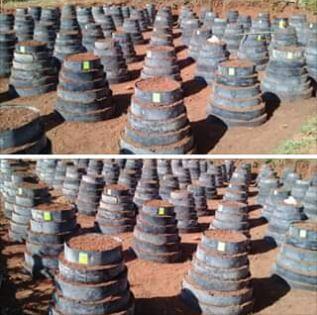
- The importance of this innovation is that it provides a solution to water scarcity. With less water and using this method, one can ensure food security, effective water utilization, and effective land utilization. Can be used when there is limited land space.
- The dam liners have a longer lifespan of over ten years as they are ultraviolet-heat treated.
- Allows smooth water flow downwards and lasts for ten years compared to sacks or old mosquito nets widely used by Kenyan farmers.
- You can plant vegetables like kales, Sukuma, carrots, onions, indigenous vegetables and other vegetables.
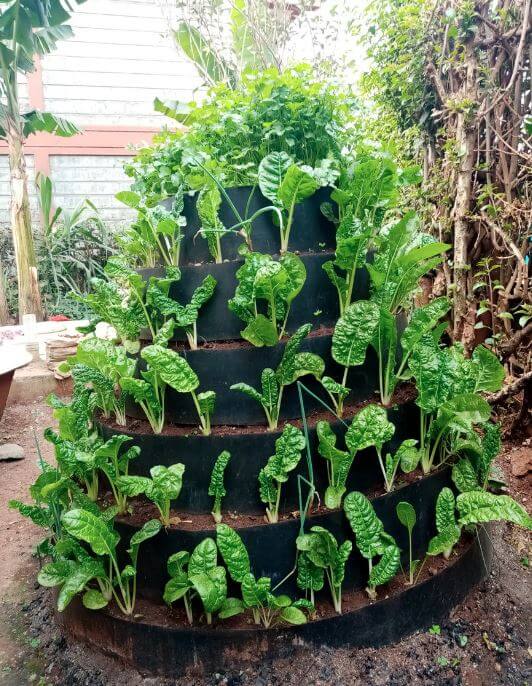
Sack garden
- A sack garden is a type of horizontal and vertical garden
- A sack garden is created by taking a breathable sack like a ‘gunia,’ putting stones horizontally at the bottom, then packing the bag with soil mixed with manure and compost. Put a vertical tube at the center packed with stones to help you build the middle vertical column as you keep packing the bag with the soil mixed in with manure. Water the bag thoroughly, on top of the stone column and the sides of the bag. The soil must be well moist. Make holes that are 15 cm apart around the bag. Do not make holes in the stone layer at the bottom of your bag. Carefully place plants into the hole and on top of the sack. Be careful not to damage the plant roots. Water the plants well, and you are done. Your sack garden is ready.
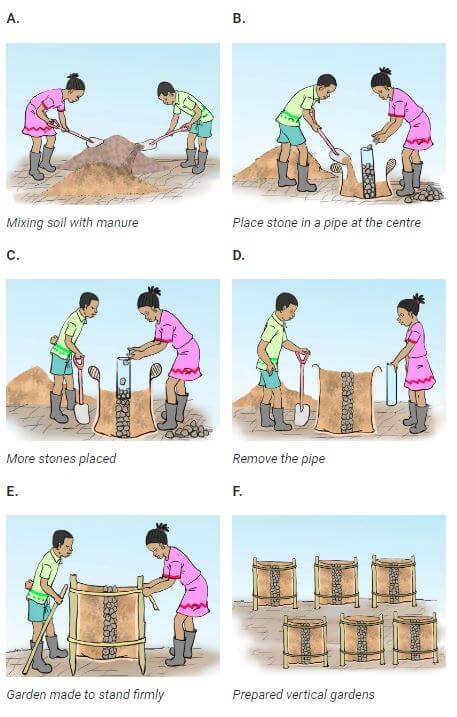
- Mixing compost manure with top soil makes soil fertile for innovative gardens
- Stone columns allow water to flow to the lower level of the sack.
- Holes are made to enable water to drain.
- Sack garden can be arranged to form vertical or horizontal innovative gardens.
- Like multi-storey farming, sack gardening allows you to grow more plants in less space. This is because the sacks prevent the root systems from spreading too far and inhibiting the growth of other plants.
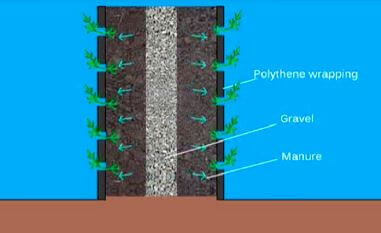
- The primary advantage of growing your plants in a sack or bag seems to be that they grow in an isolated environment. You know exactly what type of soil they are growing in, and you ultimately control what goes in it. Since the plants grow in much more isolated spaces, the risk of animals and pests (such as slugs) is significantly lower.
- By growing your plants in sacks, you can place them very close to each other without having to worry about that. As a result, you can grow more plants in less space.
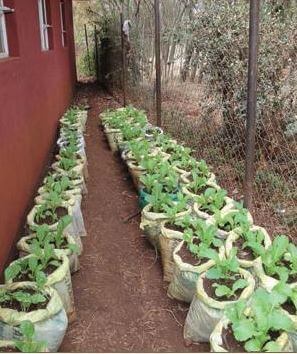
- Since you use sacks or bags to grow your plants, virtually no cleaning is also involved.
- As the amount of direct sunlight that reaches your garden changes throughout the growing season, quickly moving your plants can come in handy if some are getting too much direct sunlight during the warmest months of summer.
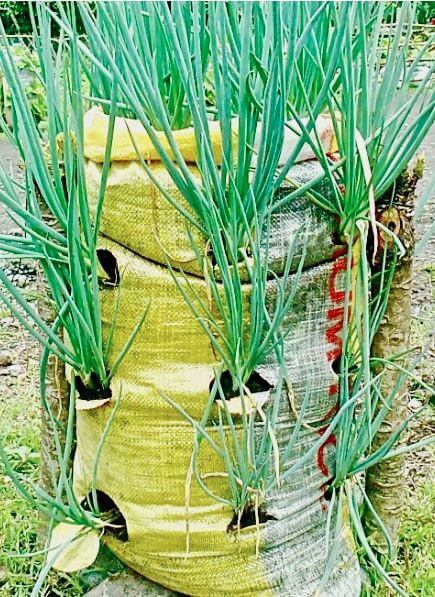
Wick irrigation garden
- This farming helps better utilize water and upcycling plastic water bottles. Numerous plastic bottles are being used in Kenya today; reusing these water bottles as planters is a great way to help the environment.
- You can grow any vegetable or herb in the bottle.
- It is a simple hydroponic system that is relatively easy to make. It utilizes a reservoir of water to feed and water the plants in place of soil.
- It uses an absorbent wick to pull moisture into the growing medium, self-watering the plant(s). This works by capillary action: as moisture in the growing medium is taken up by the plant roots or lost to evaporation, the wick will continually pull water from the reservoir below, replenishing the moisture.
- This method significantly reduces the time you need to water your plants manually.
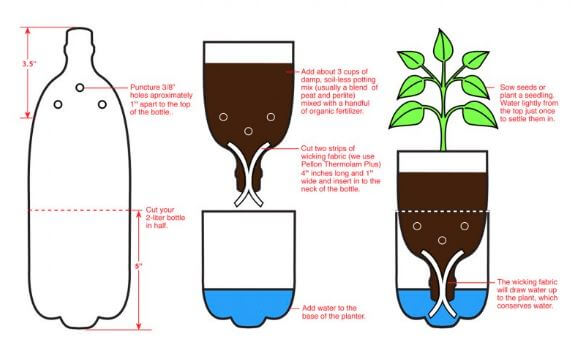
- Plastic bottles are used to make vertical gardens when placed or hanged on wooden frames or walls.
- Plastic bottles can also be painted on the outside to make them colourful.
- Painted plastic bottles can be arranged along pathways to form horizontal innovative gardens.
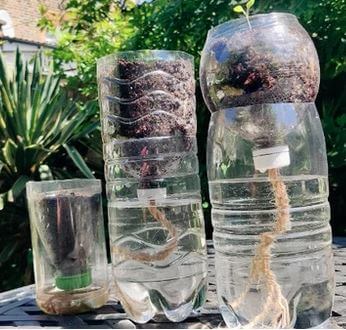
- Plastic pipes can be used to make vertical and horizontal innovative gardens for planting vegetable seeds.
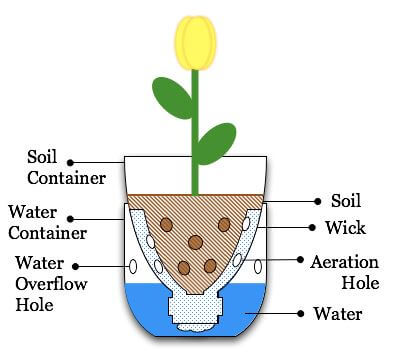
Other innovative gardening ideas
Expandable step gardens
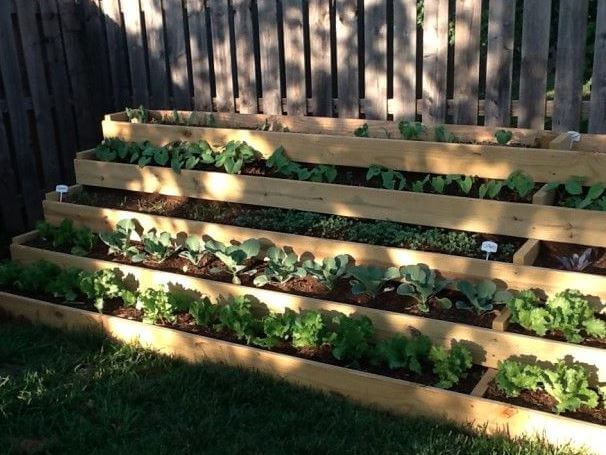
One Pot Garden
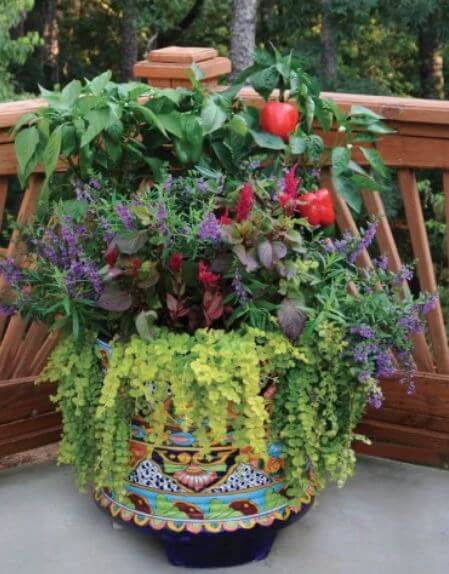
Square Foot Gardening
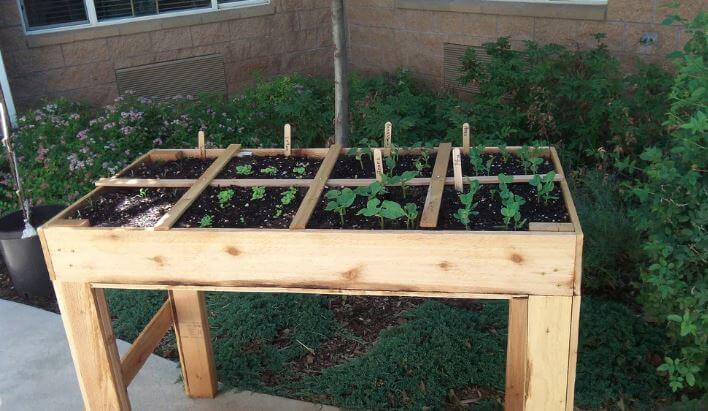
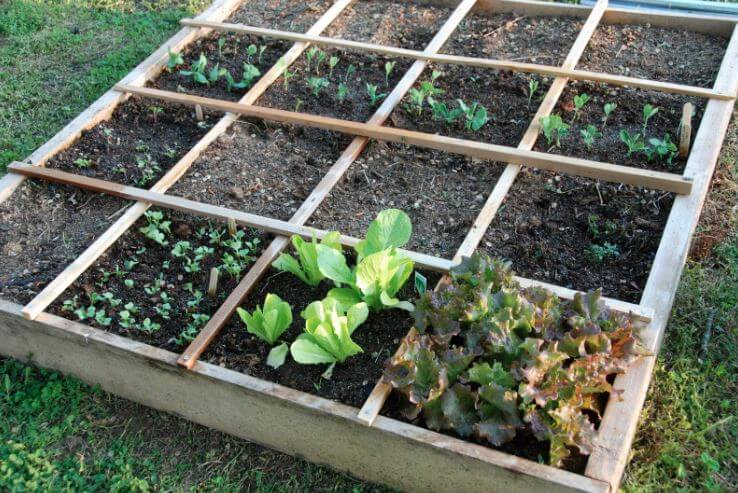
Gutter Gardens
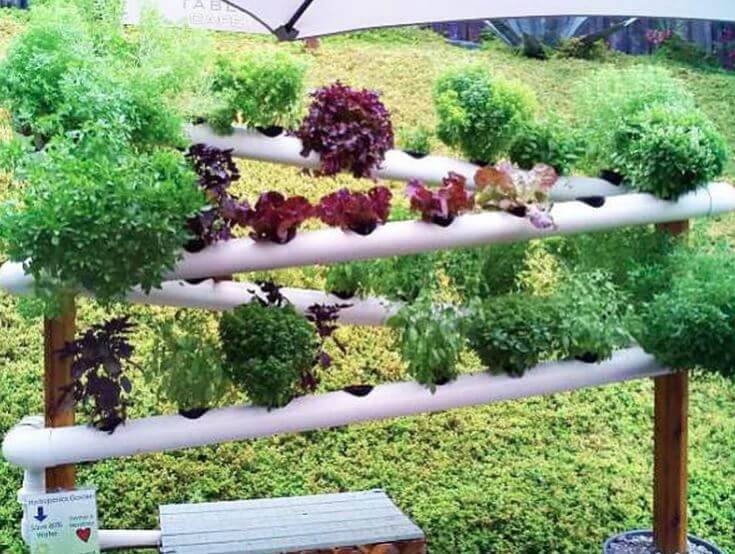
Tyre garden
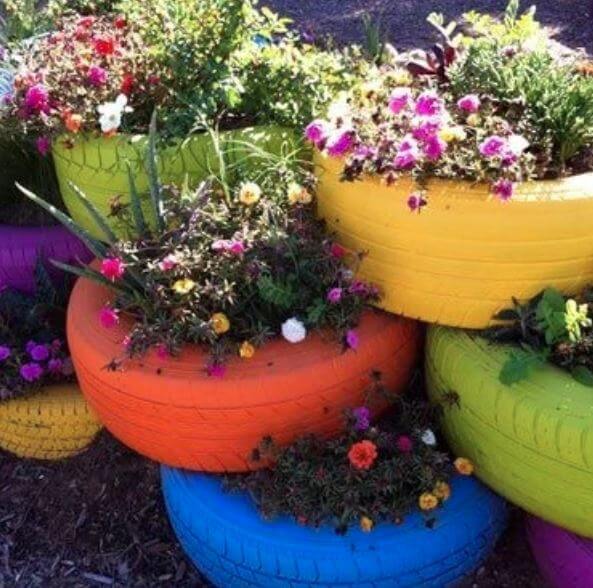
Sky Planters

Transplanting seedlings
- Seedlings to be transplanted should have a ball of soil around the roots.
- Seedlings should be transplanted late in the afternoon or when it is cloudy.
- Seeds sown in the plastic pipes should be given little water to avoid flooding them.
Gardening practices on vegetables in the innovative gardens
- Thinning
- Weeding - uprooting all roots from the innovative garden
- Watering
- Removal of diseased plants by uprooting them from the innovative gardens.
Remember to:
- Avoid damaging the roots of the vegetable crops during weeding and thinning
- Take care not to apply too much water to the plants.
- Weeds should be uprooted as soon as they appear.
- Record keeping is important for the gardening practices.
Harvesting vegetables from innovative gardens
- Only mature vegetables are harvested.
- Onion bulbs become large while leaves bend and dry off.
- Cabbage heads become firm.
- Kales, spinach, coriander, lettuce, pigweed and black nightshade are harvested when the leaves grow large.
- Avoid damage to the vegetables when harvesting.
- The vegetables are weighed after harvesting.
Importance of innovative gardens for Grade 5 learning
Students to understand that:
- Innovative gardening helps us carry out different practices responsibly.
- Some of the materials used at home can be recycled and used on the innovative gardens.
- Record keeping skills are important in a gardening project.
Revision Exercise
Questions
- Vertical innovative gardens occupy………………………….. space than horizontal innovative gardens. (More, less).
- Identify whether the innovative gardening practices below are horizontal or vertical gardenning
- Re-using plastic bottles for innovative gardening helps us:
- Increase water sources
- Control soil erosion
- Conserve the environment
- Which one of the following materials is not suitable to make a soil container for innovative gardens?
- Metal pipes
- Wooden boxes
- Sacks
- Plastic bottles
- Writing paper
- Identify the type of innovative garden shown in the following pictures.
- Harvesting kales from the innovative gardening is done when:
- Leaves are large
- Leaves turn yellow
- Leaves are small
Answers
- Less
-
- Both horizontal and vertical
- Both horizontal and vertical
- Horizontal
- Horizontal
- Control soil erosion
Conserve the environment - Metal pipes
Writing paper -
- Sack garden
- Vertical and horizontal bottle garden
- Vertical garden
- Horizontal garden
- Sack garden
- Vertical and horizontal bottle garden
- Sack garden
- Horizontal garden
- Vertical and horizontal bottle garden
- Sack garden
- Leaves are large
Domestic Animals - CBC Grade 5 Agriculture Revision Notes
- Domestic animals are the animals that are kept at home. They include cow, donkey, chicken, duck, horse, rabbit, cat, dog etc.
- Domestic animals are important to human life because:
- They provide,
- meat for food, milk, eggs
- security,
- manual Labour
- and may be sold to generate income.
- Some animals like cows, donkey, horses and rabbits produce wastes to make manure.
Animal welfare
- Domestic animals are of great use to us. They should be treated well and showed love.
- To care for domestic animals,
- They should be kept clean and
- Given medication for good production.
- Food and water should be provide pastes and
- Parasites should be controlled and treated to ensure good health among domestic animals.
- Water should be given to them and
- They should be protected from extreme temperatures.
Uses of animals
Cat
- Its kept for beauty / companionship
- Provide safety against rats at home
Rabbit
- Provides meat
- Kept for beauty at home
- Sold for money
Dog
- Provides security at home
- Used for transport
- Provides companionship
Pig
- Sold to give us money
- Provides pork and bacon
Fish
- Is a source of food
- Kept for beauty in home aquariums
Horse
- Used for sports
- Used for transport
- Used during war in the past
- Sold to make money
Camel
- Provides labour when ploughing land
- Used for transporting goods and people
- Provides fur
Bees
- Gives us honey
- Pollinate our fruit crops
- All domestic animals are important to us. Some domestic animals provide beauty at home, others provide security while others provide us various food products such as meat, milk and honey.
- Some domestic animals also provide us with transport.
- Various communities in Kenya use some of the domestic animals during cultural ceremonies e.g. the Somali community use camels as payment for dowry during marriage ceremonies.
- We should therefore love and take care of all the domestic animals. We should also encourage other people to treat them well


